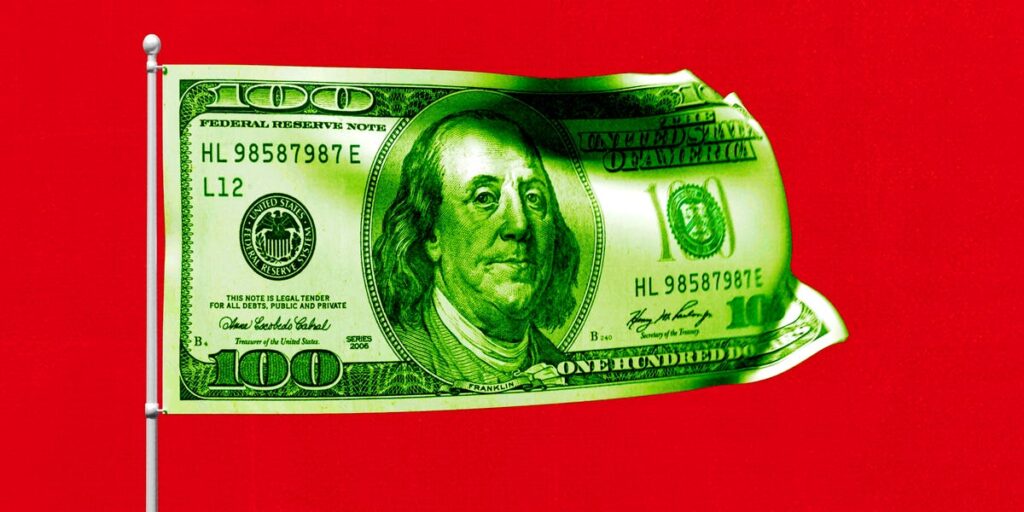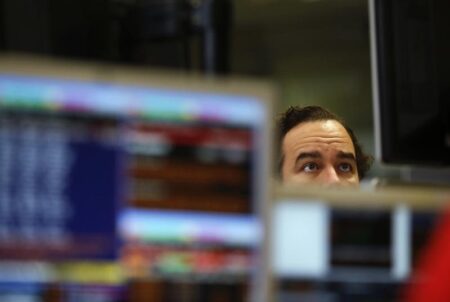- Polling suggests the economy is important to voters in this year’s presidential election.
- The economy is doing well across a wide variety of metrics.
- But there are some weak points — like a growing federal debt load.
Election Day is less than two weeks away, and the economy is top of mind for many Americans.
Twenty-eight percent of likely voters in a poll from The New York Times/Siena College from September 29 to October 6 said the economy was the “most important” issue for their vote, which was the highest share among all issues. A Pew Research Center survey from August 26 to September 2 found that among registered voters, 68% of Kamala Harris supporters and 93% of Donald Trump supporters said the economy is “very important” to their vote.
Additionally, an Associated Press-NORC Center for Public Affairs Research poll conducted in October found registered voters were nearly split on who they thought would do a better job handling different areas of the economy, such as jobs and unemployment.
The good news is that the economy is broadly doing pretty well these days.
“We’ve seen new highs for the stock market’s major averages, falling inflation, the Federal Reserve shifting into easing mode and a job market close to the level associated with full employment,” Mark Hamrick, a senior economic analyst at the financial services company Bankrate, said in a recent commentary.
While data suggests the US economy is robust, Americans may not agree. The index of current economic conditions from the University of Michigan’s Surveys of Consumers has stayed stubbornly low throughout the pandemic recovery.
Kurt Reiman, cohead of ElectionWatch at UBS Global Wealth Management, told Business Insider that he doesn’t think people feel “euphoric” about the economy. “Voters are reminded daily of the high price of goods and services — whether they’re renewing their car or home insurance, or they’re going to the grocery store,” Reiman said.
They’re not completely off base. There are a few less-rosy data points out there, like rising long-term unemployment and a historically high level of federal debt.
As people get ready to head to polling locations or vote by mail, here’s how the US economy has been looking.
The unemployment rate has been under 5% since September 2021
After it rose to around 15% during the height of the early pandemic in April 2020, the unemployment rate has fallen to historically low rates. Even though the unemployment rate ticked up to 4.3% this past July — the highest rate since October 2021 — it has dropped since.
While unemployment remains low, the average time unemployed workers were out of a job increased to 22.6 weeks in September. So, those out of work are spending more time looking for their next job.
Job gains have cooled but remain strong
The economy keeps adding jobs, but the labor market has slowed from its red-hot pandemic recovery.
The cooler-but-strong job growth is one indication that the US has continued to avoid a recession — the last one being in 2020.
There aren’t as many job openings per unemployed person as a few years ago
One key measure of the labor market has been turning against job seekers. The number of job openings per unemployed person rose to a record-high ratio in 2022 during the Great Resignation but has declined to 1.1 openings per unemployed person in August and looks more like pre-pandemic levels.
It’s not impossible to find a job, though; Hamrick said there is “still a reasonable chance that someone who’s going to be a job seeker will have a measure of success” depending on their sector and location.
The inflation rate has slowed dramatically
Inflation has been mostly slowing down after spiking in 2021 and 2022 based on year-over-year increases in the consumer price index.
While inflation has slowed, Hamrick said consumers feel constrained by still-high prices. However, Hamrick said, “Americans will continue to claw back some” lost buying power as long as inflation continues to settle down while the job market holds up.
Wages have been catching up, and real wages, which are adjusted for inflation, grew 1.5% in September from a year ago.
The Federal Reserve has targeted a soft landing where inflation comes down without mass layoffs. So far, that seems to be happening. Additionally, the Fed cut interest rates in September — the first cut in four years. There’s a high chance it will decide to do a smaller cut in November, depending on how the data looks and other factors.
Real disposable personal income per capita has been looking healthy
Real disposable personal income per capita — a widely used measure of the money people have to spend or save — spiked in the early pandemic due to stimulus checks in 2020 and 2021 and the expanded child tax credits for the 2021 tax year.
While real disposable personal income per capita cooled off as inflation accelerated in 2022, it has been gradually rising — and is above where it was before the pandemic and close to the pre-pandemic growth trend.
The S&P 500 in 2024 has hit several all-time highs
During 2024, the S&P 500 has been historically high multiple times. MarketWatch reported it has hit 47 record highs this year. This index of large publicly traded US companies reflects corporate America doing quite well, and the rising figures may be good for people’s retirement savings portfolios.
Reiman chalks it up to strong consumer spending, slowing inflation, and lower interest rates leading to higher corporate profits and valuations.
Confidence among home builders is still low compared to recent years
While the labor market is showing a lot of strength, the housing market is one area of the economy where there are some concerns. More single-family builders are feeling better about housing than a few months ago but are falling short of the confidence seen a couple of years ago. That’s based on the NAHB/Wells Fargo Housing Market Index, which tracks the health of the single-family housing market.
The index, based on what single-family builders surveyed reported, was a not-too-confident reading of 43 out of 100 in October.
Federal public debt as a share of GDP is elevated
Reiman said the Biden administration will be “handing off an economy with higher levels of debt than when taking office.” Federal debt is high compared to GDP, even looking beyond the spike of the debt as a share of GDP during the pandemic.
While federal debt as a share of GDP was slightly above 100% before the pandemic, recent figures are much higher than in the past. Federal debt was 120% of GDP in the second quarter of this year. In the long run, a high debt-to-GDP ratio may lead to expensive interest costs and future tax hikes or spending cuts.
Read the full article here















